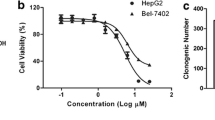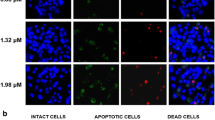Abstract
Gadolinium (Gd) compounds have important applications as MRI contrast and potential anticancer agents. The present study investigated the mechanisms of the proapoptotic effect of gadolinium chloride (GdCl3) on hepatoblastoma cell line (Hep G2) tumor cells. The experimental results indicated that GdCl3 induced apoptosis of Hep G2 at high concentration and with long time incubation; however, unlike the actions on normal cell lines, GdCl3 did not cause any oxidative stress on tumor cells. Cytochrome c (Cyt c) and apoptosis inducing factor release, Bax translocation, collapse of mitochondria membrane potential, caspase 3 and 8 activation, and Bid cleavage were observed along with a sustained activation of extracellular signal-regulated kinase (ERK) and c-Jun NH2 terminal kinase (JNK). Addition of ERK and JNK inhibitor attenuated the effect of GdCl3 induced apoptosis and Cyt c release. All the results suggested a novel mechanism that GdCl3 induced Hep G2 cell death through intrinsic and external death pathways without significant elevation of reactive oxygen species generation. The present work provided new insight to understand the mechanisms of the biological effects of GdCl3 and implications for the development of anticancer Gd agents.







Similar content being viewed by others
Abbreviations
- GdCl3 :
-
Gadolinium chloride
- Hep G2:
-
Hepatoblastoma cell line
- DMEM:
-
Dulbecco’s modified eagle’s medium
- FBS:
-
Fetal bovine serum
- AIF:
-
Apoptosis inducing factor
- Cyt c:
-
Cytochrome c
- CsA:
-
Cyclosporin A
- ROS:
-
Reactive oxygen species
- MTT:
-
3-(4, 5-Dimethylthiazole-2-yl)-2, 5-diphenyltetrazolium bromide
- PBS:
-
Phosphate-buffered saline
- PI:
-
Propidium iodide
- DCFH-DA:
-
2′, 7′-dichlorofluorescein diacetate
- JC-1:
-
5, 5′, 6, 6′-tetrachloro-1, 1′, 3, 3′-tetraethyl benzimidazol carbocyanine iodide
- FITC:
-
Fluorescein isothiocyanate
- LCFM:
-
Laser confocal fluorescence microscopy
References
Shen L, Lan Z, Sun X, Shi L, Liu Q, Ni J (2010) Proteomic analysis of lanthanum citrate-induced apoptosis in human cervical carcinoma SiHa cells. Biometals 23:1179–1189
Fu LJ, Li JX, Yang XG, Wang K (2009) Gadolinium-promoted cell cycle progression with enhanced S-phase entry via activation of both ERK and PI3K signaling pathways in NIH 3T3 cells. J Biol Inorg Chem 14:219–227
Liu H, Yuan L, Yang X, Wang K (2003) La(3+), Gd(3+) and Yb(3+) induced changes in mitochondrial structure, membrane permeability, cytochrome c release and intracellular ROS level. Chem-Biol Interact 146:27–37
Park EJ, Choi J, Park YK, Park K (2008) Oxidative stress induced by cerium oxide nanoparticles in cultured BEAS-2B cells. Toxicology 245:90–100
Yu S, Hu J, Yang X, Wang K, Qian ZM (2006) La(3+)-induced extracellular signal-regulated kinase (ERK) signaling via a metal-sensing mechanism linking proliferation and apoptosis in NIH 3T3 cells. Biochemistry 45:11217–11225
Chen C, Xing G, Wang J, Zhao Y, Li B, Tang J, Jia G, Wang T, Sun J, Xing L (2005) Multihydroxylated [Gd@ C82 (OH) 22] n nanoparticles: antineoplastic activity of high efficiency and low toxicity. Nano Lett 5:2050–2057
Ye L, Shi Z, Liu H, Yang X, Wang K (2011) Gadolinium induced apoptosis of human embryo liver L02 cell line by ROS-mediated AIF pathway. J Rare Earths 29:178–184
Xia Q, Feng X, Huang H, Du L, Yang X, Wang K (2011) Gadolinium-induced oxidative stress triggers endoplasmic reticulum stress in rat cortical neurons. J Neurochem 117:38–47
Feng XD, Xia Q, Yuan L, Huang HF, Yang XD, Wang K (2011) Gadolinium triggers unfolded protein responses (UPRs) in primary cultured rat cortical astrocytes via promotion of an influx of extracellular Ca 2+. Cell Biol Toxicol 27:1–12
Shen L, Liu Q, Ni J, Hong G (2009) A proteomic investigation into the human cervical cancer cell line HeLa treated with dicitratoytterbium (III) complex. Chem-Biol Interact 181:455–462
Yin JJ, Lao F, Meng J, Fu PP, Zhao Y, Xing G, Gao X, Sun B, Wang PC, Chen C, Liang XJ (2008) Inhibition of tumor growth by endohedral metallofullerenol nanoparticles optimized as reactive oxygen species scavenger. Mol Pharmacol 74:1132–1140
Dai Y, Li J, Li J, Yu L, Dai G, Hu A, Yuan L, Wen Z (2002) Effects of rare earth compounds on growth and apoptosis of leukemic cell lines. In Vitro Cell Dev Biol Anim 38:373–375
Su X, Zheng X, Ni J (2009) Lanthanum citrate induces anoikis of Hela cells. Cancer Lett 285:200–209
Shi DY, Xie FZ, Zhai C, Stern JS, Liu Y, Liu SL (2009) The role of cellular oxidative stress in regulating glycolysis energy metabolism in hepatoma cells. Mol Cancer 8:32
Bersted BH, Belford RL, Paul IC (1968) Crystal aand molecular structure of orthorhombic vanadyl (IV) pyridine-2, 6-dicarboxylate tetrahydrate. Inorg Chem 7:1557–1562
Hu XZ, Xu Y, Hu DC, Hui Y, Yang FX (2007) Apoptosis induction on human hepatoma cells Hep G2 of decabrominated diphenyl ether (PBDE-209). Toxicol Lett 171:19–28
Lecoeur H, Prevost MC, Gougeon ML (2001) Oncosis is associated with exposure of phosphatidylserine residues on the outside layer of the plasma membrane: A reconsideration of the specificity of the annexin V/propidium iodide assay. Cytometry 44:65–72
Smiley ST, Reers M, Mottola-Hartshorn C, Lin M, Chen A, Smith TW, Steele GD Jr, Chen LB (1991) Intracellular heterogeneity in mitochondrial membrane potentials revealed by a J-aggregate-forming lipophilic cation JC-1. Proc Natl Acad Sci USA 88:3671–3675
Oh SH, Lee BH, Lim SC (2004) Cadmium induces apoptotic cell death in WI 38 cells via caspase-dependent Bid cleavage and calpain-mediated mitochondrial Bax cleavage by Bcl-2-independent pathway. Biochem Pharmacol 68:1845–1855
Johnstone RW, Ruefli AA, Lowe SW (2002) Apoptosis: a link between cancer genetics and chemotherapy. Cell 108:153–164
Lim MLR, Lum MG, Hansen TM, Roucou X, Nagley P (2002) On the release of cytochromec from mitochondria during cell death signaling. J Biomed Sci 9:488–506
Franco R, Sánchez-Olea R, Reyes-Reyes EM, Panayiotidis MI (2009) Environmental toxicity, oxidative stress and apoptosis: Ménage à Trois. Mutat Res/Gen Tox En 674:3–22
Wang Q, Liu TT, Fu Y, Wang K, Yang XG (2010) Vanadium compounds discriminate hepatoma and normal hepatic cells by differential regulation of reactive oxygen species. J Biol Inorg Chem 15:1087–1097
Trachootham D, Alexandre J, Huang P (2009) Targeting cancer cells by ROS-mediated mechanisms: a radical therapeutic approach? Nat Rev Drug Discov 8:579–591
Matsuoka M, Igisu H (2002) Effects of heavy metals on mitogen-activated protein kinase pathways. Environ Health Prev Med 6:210–217
Mansouri A, Ridgway LD, Korapati AL, Zhang Q, Tian L, Wang Y, Siddik ZH, Mills GB, Claret FX (2003) Sustained activation of JNK/p38 MAPK pathways in response to cisplatin leads to fas ligand induction and cell death in ovarian carcinoma cells. J Biol Chem 278:19245–19256
Lau AT, Li M, Xie R, He QY, Chiu JF (2004) Opposed arsenite-induced signaling pathways promote cell proliferation or apoptosis in cultured lung cells. Carcinogenesis 25:21–28
Chiu CC, Chen JYF, Lin KL, Huang CJ, Lee JC, Chen BH, Chen WY, Lo YH, Chen YL, Tseng CH (2010) p38 MAPK and NF-[kappa] B pathways are involved in naphtho [1, 2-b] furan-4, 5-dione induced anti-proliferation and apoptosis of human hepatoma cells. Cancer Lett 295:92–99
Rai A, Maurya SK, Khare P, Srivastava A, Bandyopadhyay S (2010) Characterization of developmental neurotoxicity of As, Cd, and Pb mixture: synergistic action of metal mixture in glial and neuronal functions. Toxicol Sci 118:586–601
Clausen F, Lundqvist H, Ekmark S, Lewen A, Ebendal T, Hillered L (2004) Oxygen free radical-dependent activation of extracellular signal-regulated kinase mediates apoptosis-like cell death after traumatic brain injury. J Neurotrauma 21:1168–1182
Kim YK, Kim HJ, Kwon CH, Kim JH, Woo JS, Jung JS, Kim JM (2005) Role of ERK activation in cisplatin-induced apoptosis in ok renal epithelial cells. J Appl Toxicol 25:374–382
Bhagavathula N, Dame MK, DaSilva M, Jenkins W, Aslam MN, Perone P, Varani J (2010) Fibroblast response to gadolinium: role for platelet-derived growth factor receptor. Invest Radiol 45:769–777
Dhanasekaran DN, Reddy EP (2008) JNK signaling in apoptosis. Oncogene 27:6245–6251
Tsuruta F, Sunayama J, Mori Y et al (2004) JNK promotes Bax translocation to mitochondria through phosphorylation of 14-3-3 proteins. EMBO J 23:1889–1899
Makin GWJ, Corfe BM, Griffiths GJ, Thistlethwaite A, Hickman JA, Dive C (2001) Damage-induced Bax N-terminal change, translocation to mitochondria and formation of Bax dimers/complexes occur regardless of cell fate. EMBO J 20:6306–6315
Eskes R, Desagher S, Antonsson B, Martinou JC (2000) Bid induces the oligomerization and insertion of Bax into the outer mitochondrial membrane. Mol Cell Biol 20:929–935
Knudson CM, Brown NM (2008) Mitochondria potential, bax “activation,” and programmed cell death. Methods Mol Biol 414:95–108
Desagher S, Martinou JC (2000) Mitochondria as the central control point of apoptosis. Trends Cell Biol 10:369–377
Wang C, Youle RJ (2009) The role of mitochondria in apoptosis. Annu Rev Genet 43:95–118
Jiang CM, Xu CQ, Mi Y, Li HZ, Wang R, Li WM (2010) Calcium-sensing receptor induced myocardial ischemia/reperfusion injury via the C-Jun NH2-terminal protein kinase pathway. Acta Cardiol Sin 26:102–110
Acknowledgments
This work was supported by the National Natural Science Foundation of China (nos. 20671008 and 20971008).
Author information
Authors and Affiliations
Corresponding authors
Rights and permissions
About this article
Cite this article
Ye, L., Shi, Z., Liu, H. et al. GdCl3 Induced Hep G2 Cell Death through Mitochondrial and External Death Pathways without Significant Elevation of ROS Generation. Biol Trace Elem Res 151, 148–155 (2013). https://doi.org/10.1007/s12011-012-9538-y
Received:
Accepted:
Published:
Issue Date:
DOI: https://doi.org/10.1007/s12011-012-9538-y




